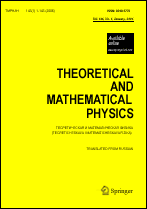|
This article is cited in 2 scientific papers (total in 2 papers)
Mutual transition of Andreev and Majorana bound states in a superconducting gap
Yu. P. Chuburina, T. S. Tinyukovab
a Udmurt Federal Research Center of the Ural Branch of the Russian Academy of Sciences, Izhevsk, Russia
b Udmurt State University, Izhevsk, Russia
Abstract:
Using the Bogoliubov–de Gennes Hamiltonian, we analytically study two models with superconducting order, the p-wave model with an impurity potential and the s-wave nanowire model with superconductivity induced by the proximity effect with an impurity potential in a Zeeman field with a spin–orbit interaction. Using the Dyson equation, we study conditions for the emergence of Andreev bound states with energies close to the boundary of the superconducting gap and the possibility for these states to pass into Majorana-like bound states. We prove that in the topological phase (in the p-wave case also in the trivial phase) for both models, the Andreev bound states with energy close to the boundary of the superconducting gap can exist, but although their emergence in the p-wave model is due to the appearance of a (nonmagnetic) impurity, they appear in the s-wave model only as a result of a local perturbation of the Zeeman field. For both models, the transition of the Andreev bound states into the Majorana states (and back) is impossible in the topological phase, which is explained by the topological protection of the Majorana-like bound states in the topological phase.
Keywords:
Bogoliubov–de Gennes Hamiltonian, superconducting gap, Andreev bound state, Majorana bound state.
Received: 02.07.2020
Revised: 13.08.2020
Citation:
Yu. P. Chuburin, T. S. Tinyukova, “Mutual transition of Andreev and Majorana bound states in a superconducting gap”, TMF, 205:3 (2020), 484–501; Theoret. and Math. Phys., 205:3 (2020), 1666–1681
Linking options:
https://www.mathnet.ru/eng/tmf9951https://doi.org/10.4213/tmf9951 https://www.mathnet.ru/eng/tmf/v205/i3/p484
|


| Statistics & downloads: |
| Abstract page: | 279 | | Full-text PDF : | 92 | | References: | 41 | | First page: | 7 |
|




 Contact us:
Contact us: Terms of Use
Terms of Use
 Registration to the website
Registration to the website Logotypes
Logotypes









 Citation in format
Citation in format 
